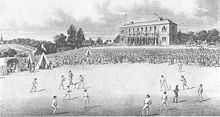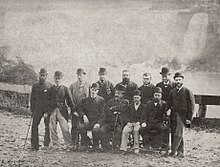HISTORY OF CRICKET
HISTORY OF CRICKET :
Cricket was probably created during Saxon or Norman times by children living in the Weald, an area of dense woodlands and clearings in south-east England that lies across Kent and Sussex .
The sport of cricket has a known history beginning in the late 16th century. Having originated in south-east England, it became the country's national sport in the 18th century and has developed globally in the 19th and 20th centuries. International matches have been played since 1844 and Test cricket began, retrospectively recognised, in 1877. Cricket is the world's second most popular spectator sport after association football (soccer). Governance is by the International Cricket Council (ICC) which has over one hundred countries and territories in membership although only twelve currently play Test cricket.
✦ Derivation of the name of "cricket" :
A number of words are thought to be possible sources for the term "cricket". In the earliest definite reference, it was spelled creckett. The name may have been derived from the Middle Dutch krick , meaning a stick; or the Old English cricc or cryce meaning a crutch or staff, or the French word criquet meaning a wooden post.The Middle Dutch word krickstoel means a long low stool used for kneeling in church; this resembled the long low wicket with two stumps used in early cricket.
✦ Patronage and players :
Gambling introduced the first patrons because some of the gamblers decided to strengthen their bets by forming their own teams and it is believed the first "county teams" were formed in the aftermath of the Restoration in 1660, especially as members of the nobility were employing "local experts" from village cricket as the earliest professionals. The first known game in which the teams use county names is in 1709 but there can be little doubt that these sort of fixtures were being arranged long before that. The match in 1697 was probably Sussex versus another county.
✦ Laws of Cricket :
It's not clear when the basic rules of cricket such as bat and ball, the wicket, pitch dimensions, overs, how out, etc. were originally formulated. In 1728, the Duke of Richmond and Alan Brodick drew up Articles of Agreement to determine the code of practice in a particular game and this became a common feature, especially around payment of stake money and distributing the winnings given the importance of gambling.
In 1744, the Laws of Cricket were codified for the first time and then amended in 1774, when innovations such as lbw, middle stump and maximum bat width were added. These laws stated that "the principals shall choose from amongst the gentlemen present two umpires who shall absolutely decide all disputes". The codes were drawn up by the so-called "Star and Garter Club" whose members ultimately founded MCC at Lord's in 1787. MCC immediately became the custodian of the Laws and has made periodic revisions and recodifications subsequently.
The game also underwent a fundamental change of organisation with the formation for the first time of county clubs. All the modern county clubs, starting with Sussex in 1839, were founded during the 19th century. No sooner had the first county clubs established themselves than they faced what amounted to "player action" as William Clarke created the travelling All-England Eleven in 1846. Though a commercial venture, this team did much to popularise the game in districts which had never previously been visited by high-class cricketers. Other similar teams were created and this vogue lasted for about thirty years. But the counties and MCC prevailed.
The growth of cricket in the mid and late 19th century was assisted by the development of the railway network. For the first time, teams from a long distance apart could play one other without a prohibitively time-consuming journey. Spectators could travel longer distances to matches, increasing the size of crowds. Army units around the Empire had time on their hands, and encouraged the locals so they could have some entertaining competition. Most of the Empire embraced cricket, with the exception of Canada.
In 1864, another bowling revolution resulted in the legalisation of overarm and in the same year Wisden Cricketers' Almanack was first published. W. G. Grace began his long and influential career at this time, his feats doing much to increase cricket's popularity. He introduced technical innovations which revolutionised the game, particularly in batting.
✦ International cricket begins
The first ever international cricket game was between the US and Canada in 1844. The match was played at the grounds of the St George's Cricket Club in New York .
In 1859, a team of leading English professionals set off to North America on the first-ever overseas tour and, in 1862, the first English team toured Australia. Between May and October 1868, a team of Australian Aborigines toured England in what was the first Australian cricket team to travel overseas.
In 1877, an England touring team in Australia played two matches against full Australian XIs that are now regarded as the inaugural Test matches. The following year, the Australians toured England for the first time and the success of this tour ensured a popular demand for similar ventures in future. No Tests were played in 1878 but more soon followed and, at The Oval in 1882, the Australian victory in a tense finish gave rise to The Ashes.
South Africa became the third Test nation in 1889.
✦ Balls per over :
Cricket started with four balls per over. In 1889 the four balls per over was replaced by a five balls per over and then this was changed to the current six balls per over in 1900. Subsequently, some countries experimented with eight balls per over. In 1922, the number of balls per over was changed from six to eight in Australia only. In 1924 the eight balls per over was extended to New Zealand and in 1937 to South Africa. In England, the eight balls per over was adopted experimentally for the 1939 season; the intention was to continue the experiment in 1940, but first-class cricket was suspended for the Second World War and when it resumed, English cricket reverted to the six ball over. The 1947 Laws of Cricket allowed six or eight balls depending on the conditions of play. Since the 1979/80 Australian and New Zealand seasons, the six balls per over has been used worldwide and the most recent version of the Laws in 2000 only permits six ball overs.
✦ World Series Cricket :
The money problems of top cricketers were also the root cause of another cricketing crisis that arose in 1977 when the Australian media magnate Kerry Packer fell out with the Australian Cricket Board over TV rights. Taking advantage of the low remuneration paid to players, Packer retaliated by signing several of the best players in the world to a privately run cricket league outside the structure of international cricket. World Series Cricket hired some of the banned South African players and allowed them to show off their skills in an international arena against other world-class players. The schism lasted only until 1979 and the "rebel" players were allowed back into established international cricket, though many found that their national teams had moved on without them. Long-term results of World Series Cricket have included the introduction of significantly higher player salaries and innovations such as coloured kit and night games.
✦ Limited-overs cricket :
In the 1960s, English county teams began playing a version of cricket with games of only one innings each and a maximum number of overs per innings. Starting in 1963 as a knockout competition only, limited-overs cricket grew in popularity and, in 1969, a national league was created which consequently caused a reduction in the number of matches in the County Championship.
Although many "traditional" cricket fans objected to the shorter form of the game, limited-overs cricket did have the advantage of delivering a result to spectators within a single day; it did improve cricket's appeal to younger or busier people; and it did prove commercially successful.
The first limited-overs international match took place at Melbourne Cricket Ground in 1971 as a time-filler after a Test match had been abandoned because of heavy rain on the opening days. It was tried simply as an experiment and to give the players some exercise, but turned out to be immensely popular. limited-overs internationals (LOIs or ODIs—one-day internationals) have since grown to become a massively popular form of the game, especially for busy people who want to be able to see a whole match. The International Cricket Council reacted to this development by organising the first Cricket World Cup in England in 1975, with all the Test-playing nations taking part.
✦ Start of 21th century of Cricket
In June 2001, the ICC introduced a "Test Championship Table" and, in October 2002, a "One-day International Championship Table". As indicated by ICC rankings, the various cricket formats have continued to be a major competitive sport in most former British Empire countries, notably the Indian subcontinent, and new participants including the Netherlands. In 2017, the number of countries with full ICC membership was increased to twelve by the addition of Afghanistan and Ireland.
The ICC expanded its development programme, aiming to produce more national teams capable of competing at the various formats. Development efforts are focused on African and Asian nations, and on the United States. In 2004, the ICC Intercontinental Cup brought first-class cricket to 12 nations, mostly for the first time. Cricket's newest innovation is Twenty20, essentially an evening entertainment. It has so far enjoyed enormous popularity and has attracted large attendances at matches as well as good TV audience ratings. The inaugural ICC Twenty20 World Cup tournament was held in 2007. The formation of Twenty20 leagues in India – the unofficial Indian Cricket League, which started in 2007, and the official Indian Premier League, starting in 2008 – raised much speculation in the cricketing press about their effect on the future of cricket.






Ohh...!!Great..🤘 Thanx for providing info about cricket history..🤞💫🤙
ReplyDeleteDamn
ReplyDeleteThat's nice information .
ReplyDeleteI gain a lot of information through this page.